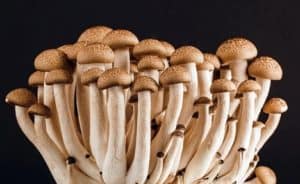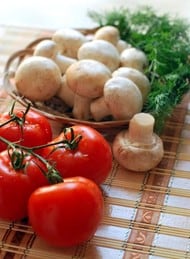Are Mushrooms a Vegetable & Where Do They Fit on the Food Pyramid?

It’s no secret that mushrooms have been part of the human diet for decades and are a delight in a vast assortment of dishes. However, there’s one question that keeps cropping up. Are mushrooms a vegetable? While mushrooms are typically classified as fungi, they are not a vegetable. If that’s the case, where do they fit on the food pyramid?
Given that mushrooms are not plants, they are not categorized as vegetables or fruits. Instead, they belong to a unique kingdom. However, for practical reasons, we usually treat mushrooms as a vegetable or meat substitute in the kitchen when it comes to how we cook them.
Image: Brown mushrooms
Why Mushrooms Are Not Vegetables
All fruits and vegetables stem from plants. That’s why vegetables can be a part of the plant that it uses for reproduction, as is the case with artichokes, peas, tomatoes, eggplants, beans, peppers, and cucumbers.
For other vegetables, we consume most or all of the plant, for instance, celery, onions, cauliflower, spinach, or lettuce. The commonality among all plants is that they acquire energy from the sun and use the chlorophyll in their cells to turn it into energy for optimal functioning. Chlorophyll is the matter that makes plants green.
Are Mushrooms Categorized As Fruits?
If mushrooms are not biologically categorized as a vegetable, is it a no-brainer that they’re not fruits either? Although they are not fruits, there’s no denying that they gravitate more towards fruits than vegetables.
The mushrooms we know and love cooking, such as the oyster mushroom species, are a small component of the bigger, living, and growing part of the mushroom known as the mycelium that typically grows below ground or on logs.
The fresh mushrooms you see are the reproductive component of the fungi. Therefore, their purpose is to grow and spread the reproductive bits of the mushroom known as the spores, essentially the mushroom seeds.
In that regard, mushrooms can be considered a type of fruit. The only difference is that they don’t originate from plants and don’t require flowers or pollination that are usually required to generate fruit in the plant kingdom.
Where Do Mushrooms Fit on the Food Pyramid?
Mushrooms lack chlorophyll which means they don’t convert sunlight into energy. Instead, they obtain their much-needed nutrients from decaying and dead matter or the root systems of living plants. As such, they are classified as a separate kingdom of life known as fungi. Other members of this kingdom are mold and yeast.
Mushrooms fall into three main categories.
Mycorrhizal
These form a symbiotic relationship with healthy, living tree roots. While they derive their nutrients from trees, they also give back by helping to form a healthier and bigger root system. Examples of mycorrhizal mushrooms are truffles, porcini, and chanterelles.
Parasitic
While these mushroom species reside on living trees, they don’t give anything back. Due to their parasitic nature, they take nutrients from a tree until it dies.
Saprotrophic
These mushroom species reside on organic matter such as plant roots, fallen leaves, and dead trees that parasitic mushrooms have killed. They extract nutrients such as minerals and carbon dioxide from organic matter. Examples of Saprotrophic mushrooms are the white button mushroom, cremini mushroom, and shiitake mushroom.
The mushrooms we consume are a fraction of the overall fungus. Inside or underground trees, all types of mushrooms begin as a white fluffy root system known as mycelium. It constitutes most of the fungus.
Furthermore, the majority of its life is spent in this phase. Mycelium can remain hidden for years until temperature, humidity, and other factors are ideal before they produce mushrooms.
Mushrooms are the fruit of the fungus which means as they grow, they open to release spores that are the seeds of fungi. Once released, the wind blows these spores and starts growing another mycelium colony elsewhere.
Mushrooms in the Culinary World
Let’s face it. In the kitchen, we consider mushrooms to be vegetables for practical uses. After all, we cook mushrooms similarly to vegetables. Although peppers and tomatoes are scientifically classified as fruits, we consider them vegetables in the culinary world.
When cooking various dishes, the taste or flavor takes precedence compared to the scientific details of reproduction or biology.
While mushrooms are cooked similarly to vegetables, their bold and savory flavor coupled with meaty texture makes them an excellent superfood and meat substitute. Therefore, it’s not surprising that a large Portobello mushroom cap is the go-to beef patty substitute.
Furthermore, when sliced into pinky-sized strips, these species are ideal finger food for kids. You can also chop them up and use them in place of meat in wraps or tacos.

What Are Kingdoms In Biology?
It’s worth keeping in mind that the biological kingdoms are human-made rather than a fact of nature. Scientists use kingdoms to classify various forms of life on Earth for convenience. They agree on particular traits that differentiate life forms to determine their respective kingdom.
Mushrooms were regarded as a primary part of the plant kingdom until 1969, when Robert Whittaker introduced the fifth kingdom as fungi. Before then, only four kingdoms of life existed, namely Animalia, Monera, Plantae, and Protista.
Image: Mushrooms in a basket
Since then, the taxonomical system has evolved and now consists of seven kingdoms: Animalia, Archaea, Plantae, Bacteria, Chromista, Fungi, and Protozoa. Given the wealth of fungi species in existence, scientists realized that they required their kingdom to classify them and differentiate them from plants.
Rather than nature making this distinction, the line is usually blurred between animals, fungi, and plants. For instance, the Venus Fly Trap is a carnivorous plant that feeds on insects and small animals such as frogs. Let’s discuss the major differences between fungi, plants, and animals.
- Plants have chlorophyll and convert sunlight into food via photosynthesis. They usually consist of roots and leaves and are immobile compared to animals.
- Animals consume their food, that’s usually plants or other animals, and at times fungi. Contrary to fungi and plants, animals inhale oxygen and exhale carbon dioxide. They’re also locomotive compared to fungi and plants.
- Fungi depend on decaying or dead animal or plant matter to obtain their nutrients, given their lack of chlorophyll. Additionally, fungi lack the cellulose that plant cells contain. Instead, they have chitin, the same matter found in crustacean and insect shells. They lack seeds, roots, or leaves and don’t require light to flourish.
Are Mushrooms Great for Consumption?
From a nutritional standpoint, the US Department of Agriculture classifies mushrooms as vegetables because they contain a ton of the same nutritional benefits. Additionally, mushroom consumption provides a wealth of nutrients that are not as common in vegetables.
For instance, mushrooms are a potent source of pantothenic acid, Vitamin D and B vitamins, copper, niacin, and selenium. Therefore, they aid in bridging the gap between the available nutrients in meat, plants, and grains.
Edible mushrooms come in various types, each having its unique nutritional profile, texture, shape, and flavor. Mushrooms are also regarded as Adaptogens, which means they help your body deal with various types of stress and enhance physical functions. Species such as the Lion’s Mane and Chaga boost immunity.
Mushrooms are loaded with antioxidants and possess anti-aging properties. The compounds they contain are best suited for neutralizing the molecules that can wreak havoc on your body (free radicals) and cause cancer. It’s therefore not surprising that dogs also consume mushrooms for healthy nutrition.
Button mushrooms are superior to carrots, green beans, peppers, and tomatoes when it comes to the level of antioxidants. The best part is that the antioxidants that mushrooms have are not inactivated or destroyed with heat.
Are Mushrooms an Environmentally-Friendly Food Option Compared to Vegetables?
If you’re eco-conscious, you’re keen on the source of your food. More people are gravitating towards consuming sustainable and local agriculture. The good news is that mushrooms are a sustainable food choice.
The mushroom farms on which they are commercially grown can recycle byproducts such as crushed cocoa shells, soybean hulls, corn cobs, waste coffee grounds, and peanut hulls from various agricultural sectors.
These materials form a substrate rich in nutrients on which mushrooms can thrive that would otherwise go to waste. Once the mushrooms have fully matured, the substrate can be composed to create an excellent soil amendment that also ushers in the perks of added fungi.
Given that commercial mushrooms are almost exclusively grown indoors, they occupy less land space compared to their traditional counterparts. Growers can optimally regulate environmental factors in an indoor setting, cutting down on energy needs such as water.
Modern mushroom farms have impressive energy efficiency and a small carbon footprint compared to traditional agriculture. It doesn’t come as a surprise that mushroom farms utilize the heat stemming from compost to warm their facilities.
Given their short shelf life, mushrooms don’t travel well, which means most grocery store mushrooms are grown locally rather than being imported from other countries.
Conclusion
The answer to the question, ‘are mushrooms a vegetable?’ varies. From a biological standpoint, mushrooms aren’t vegetables and have been classified into a kingdom known as fungi for decades.
However, in the culinary world, mushrooms are usually treated as a vegetable and used in various recipes where you’d add vegetables. They can be used in mushroom soup, for stir fry, or any other delicious recipe you may come across. Therefore, while mushrooms are not a vegetable, you can consider and treat them as such in the kitchen.



